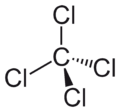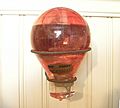Carbon tetrachloride facts for kids
Carbon tetrachloride, also known as carbon tet or Freon 10, is a chemical compound. Its chemical formula is CCl4. This means it has one carbon atom and four chloride atoms. It used to be very common in things like fire extinguishers. However, it is now known to be harmful to people and the environment.
Contents
What is Carbon Tet Like?
Carbon tetrachloride is a clear liquid. It has a sweet smell, a bit like ether. This chemical evaporates quickly into the air. It is good at dissolving fats, oils, and even iodine. It does not burn easily. But if it gets very hot, it can create a dangerous gas called phosgene.
How is Carbon Tet Made?
Carbon tetrachloride is made by mixing methane with chlorine. This chemical reaction is similar to how methane burns. When it is made, another substance called hydrogen chloride is also created. In the past, it was made by reacting carbon disulfide with chlorine.
What Was Carbon Tet Used For?
The use of carbon tetrachloride has greatly decreased. This is because it is known to be bad for people's health. Many also believe it harms the ozone layer in our atmosphere. Today, it is rarely used for anything.
In the past, it was used in fire extinguishers. It was also used to make freon. Freon was used in dry cleaning and as a refrigerant in things like refrigerators.
Is Carbon Tet Safe?
Carbon tetrachloride is very poisonous. It can seriously harm your liver, kidneys, and nervous system. Scientists also think it might cause cancer. Because of these dangers, it is not used much anymore.
Related pages
Images for kids
See also







